Pump Handbook by Igor J. Karassik, Joseph P. Messina, Paul Cooper, Charles C. Heald - 3rd edition
Подождите немного. Документ загружается.

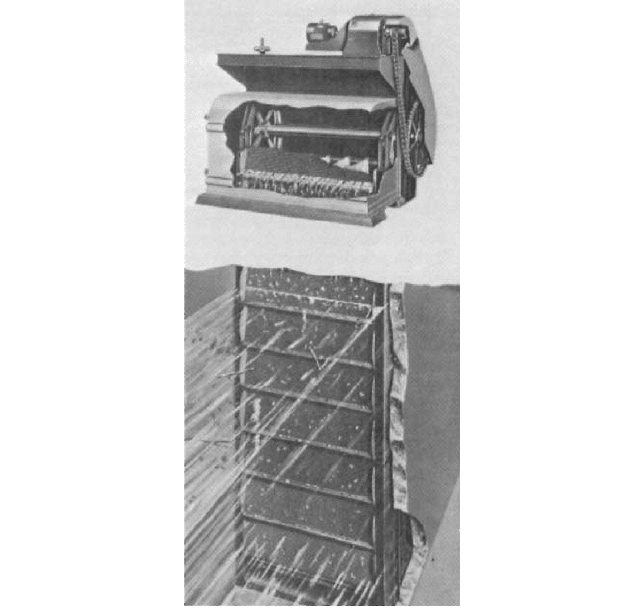
10.16 CHAPTER TEN
FIGURE 11 Traveling water screen (Envirex Inc., a Rexnord Company)
the screen is limited to 2 ft/s (0.6 m/s) unless environmental considerations require lower
velocities, the pit cross section may be determined by screen requirements. If flow is such
that a maximum-width screen available would be too long (deep) for practical or economic
reasons, two screens may be employed with a center pier. In this case, the distance to the
pump should be increased 50% over single-screen distance. Piers should be rounded
(radiused) on the upstream side and ogived (tapered to a small radius) on the downstream
side.Any corners at the sidewalls should be faired at small angles to the opening and wall
to prevent pockets where eddies can form.
The trash collected by the screens must be disposed of. Traveling screens carry trash
up into a hood above the operating floor, at which point a series of spray nozzles wash the
trash into a trough leading into a disposal area (Figure 13). The nozzles are supplied by
pumps sized for 200 to 300 gpm (45 to 68 m
3
/h) with pressures of 60 to 100 lb/in
2
(413 to
690 kPa). These pumps are normally deep-well turbine multistage units. They are located
in the clear well, if possible, close to a wall. If this is not possible, they can be suspended
in the circulating water pit, to one side and ahead of the main pumps. Care must be taken
that they do not disturb the flow to the larger pumps. Their submergence requirements
are usually less than those of the main pumps, and this allows use of the pump setting
that gives the least interference with either pump flow.
It is possible to have these pumps also dewater the pit.This will require additional pip-
ing and valves and a more careful location of the pump because it will, of necessity, be close
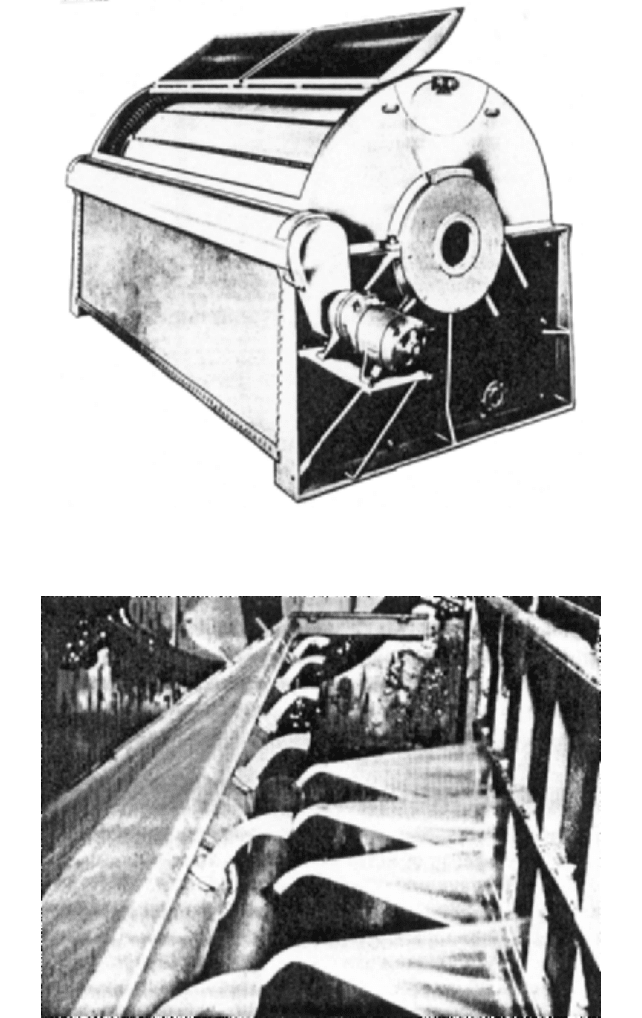
10.1 INTAKES, SUCTION PIPING, AND STRAINERS 10.17
FIGURE 12 Drum filter (Green Bay Foundry and Machine Works)
FIGURE 13 Spray nozzle cleaning of baskets on traveling water screens (Envirex Inc., a Rexnord Company)
10.18 CHAPTER TEN
to the bottom of the pit. A small chamber off the main pit, located far enough from the
main pumps to avoid eddying, will be required.
The direction of the flow from the forebay through the screens and into the pump area
should be continuous. Avoid right-angle screens, through which flow must change direc-
tion at least once and possibly twice. If screens must be at an angle to the flow into the
pumps, increase the screen-to-pump distance by 100%. Environmental considerations may
increase the possibility of problems in this area.
Environmental Considerations Suction pit requirements will vary according to
whether hydraulic or structural standpoints are being considered. Both of these may also
be in conflict with environmental considerations.
A design to accommodate fish limitations was mentioned briefly in a previous para-
graph. Fish react to a horizontal velocity but are not aware of a pull in a vertical direction.
Thus, to keep them from entering the inlet, a horizontal flow must be established at a
velocity low enough to permit fish to escape.
Intakes that take their flow directly from a river may have a high velocity that would
trap fish. Even if the velocities are lowered to reasonable screen levels
—
2 ft/s (0.6 m/s)
—
fish may still be drawn into the screen area and carried up to trash disposal.
When the source of a water supply system is a body of water containing fish, steps
must be taken to prevent undue disturbance and destruction of the fish. A site survey
should determine
• The intake location furthest from natural feeding areas and from attractive, or “trap,”areas
• The number of species involved
• The size range of each species and whether they are anadromous or settled
Sites for intakes should not be selected near feeding areas for large schools of fish (kelp
beds, coral reefs, and similar attractive spots). Sheltered spots most suitable for intake
flows may also be most attractive to fish.
Next, total flow, probable intake size, and the velocities at inlet, through screens, and
at trashracks should be determined. Variations in flow throughout the year and tempera-
ture ranges in winter to summer should be available.
The best source of information about local fish is marine biologists who have studied the
local areas. They may not only have information on fish habits, feeding patterns, popula-
tion, and so on, but may also have test information about the fish swimming ability. If they
do not already have this information, they can probably run a survey to develop the data.
The most difficult problem to overcome is related to small fish. Screen openings must
be held to a minimum, and under velocity conditions, small fish have much less
swimming-sustaining ability than larger fish, both in speed and in duration time. In a
given steam flow (such as is generated by pumps with inlet water going through screens),
a fish must have the ability to sustain a given speed against this flow for a certain length
of time. When it weakens, it will fall into the current flow and will be impaled against the
screen and destroyed. If the fish senses the velocity early enough, and has an alternate
route, it can use darting speed to escape. Or it can follow another attraction (cross veloc-
ity flow into a separate chamber or a light attraction to the chamber) and be removed on
an elevator or pumped out to a safety channel (Figure 14). Migrating fish need a continu-
ation channel to restore their interrupted journey.
In designing an intake, it is necessary to keep the velocity below 0.5 ft/s (0.15 m/s)
through the screen to avoid drawing fish into the screen. For a tube inlet away from shore,
a horizontal velocity cap (Figure 5) should be placed over the inlet. This will prevent fish
from being subject to a vertical velocity and will allow them to maintain a horizontal veloc-
ity that will direct them away from the inlet. Alternatively, a cross flow can be created that
will propel or attract the fish to one side of the inlet area. From there, they can be directed
into a bypass pool and lifted back to their own living area, or they can be sent around the
plant to a downstream location. If they are anadromous, they can be sent to an upstream
rendezvous. Piers and screens should be kept flush across their inlet face to prevent
attractive pockets where fish can hide and be drawn into the screens when they weaken.
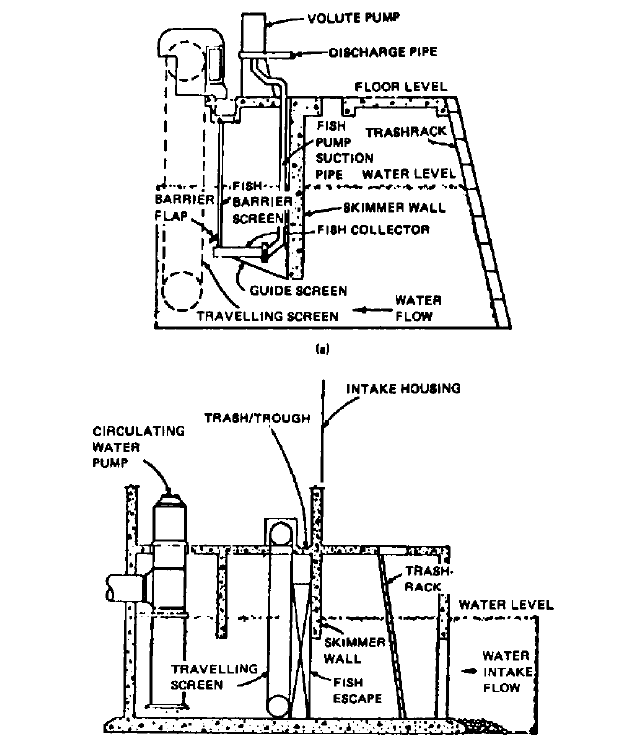
10.1 INTAKES, SUCTION PIPING, AND STRAINERS 10.19
FIGURE 14 (a) Fish pump prevents entrapment on traveling screen (Detroit-Edison). (b) Fish escape allows fish
to bypass screen area.
Inlet screen areas should be in small sections rather than one long face so a fish will
not be trapped in the center and find it too far to swim to safety after it realizes its predica-
ment. The maximum deterrent flow is about 10 ft/s (3 m/s), but this may be too much dis-
turbance for the flow to the pumps. Smaller areas allow short-term limits for enticing fish
away from the inlet, and survival will be much higher.
Fish congregating at an inlet or in a forebay pool can be crowded or herded to an out-
let point by the use of vertical nets or horizontal screens. In a direct channel, horizontal
moving screens can route fish past a sloping (relative to stream flow, say 35 degrees) mov-
ing screen. This results in directing fish to a narrow outlet at one side, leading to an out-
let channel away from the main inlet.
The Environmental Protection Agency has had a major impact on plant design since
the passage of the Federal Water Control Act of 1972 (as amended) in the US. Enforcement
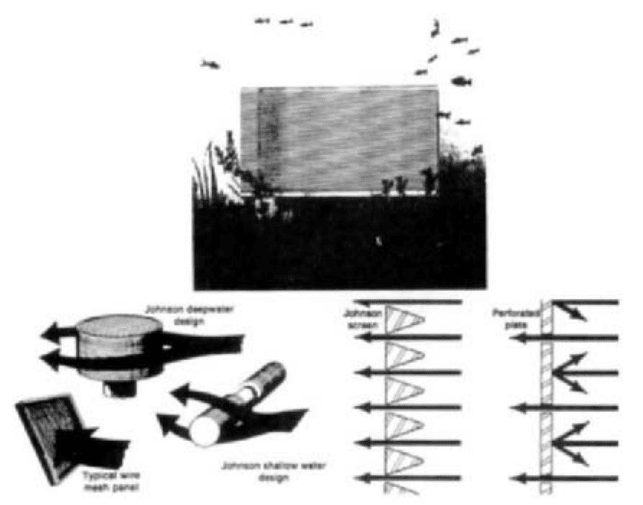
10.20 CHAPTER TEN
of Section 316a regarding thermal effluent has softened somewhat as later studies indi-
cate that the effects of heat distribution on marine life are variable. Section 316b, however,
covers every aspect of best-known technology and is applicable to any facility using a
water intake structure.
Young fish must be kept from impinging on inlet screens. This can be accomplished by
• Lowering the velocity through the inlet screens
• Diverting or attracting the fish to other areas
• Providing restraints at inlets
• Using fish buckets and elevators to remove the fish before they can enter the plant area
• In short, by helping the fish avoid contact with the intake to the greatest extent possible
Obviously, trash and fish must be handled in separate areas, and screen wash pres-
sures must be lowered to prevent harm to the fish.
Entrainment of marine organisms too small to be restrained by normal screens causes
further problems in areas where such organisms normally develop. If the intake structure
must be located in such an area, extensive information must be gathered at the site. Ana-
lyzing as much data as are available, in conjunction with plant flow and location require-
ments, may give the designer some idea of which equipment to select.
Small slot-width wedgewire screens (Figure 15) are now being furnished in larger
sizes, and, with their very low inlet velocity and backflushing capability, offer one good
approach to reducing entrainment. Sand, chemical, and cloth filters may suit some situa-
tions, but backflushing and cleaning problems make them less attractive costwise.
Equipment may consist of any combinations of
FIGURE 15 V-shaped slotted screen provides velocity control to avoid attracting fish and good air or water
backflushing for debris cleanup (Johnson Division, UOP).
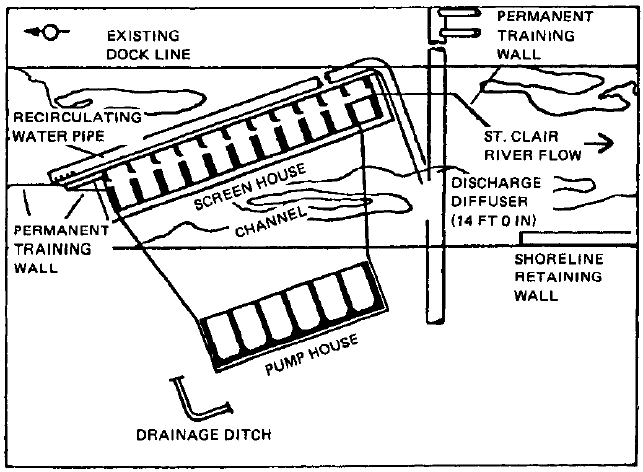
10.1 INTAKES, SUCTION PIPING, AND STRAINERS 10.21
1. Stationary screens
a. Bar racks in various attitudes (Figure 10), with or without automatic rakes
b. Air bubble, lighting, or electric heaters
c. Underground, as in Ranney wells (Figure 6)
2. Moving screens
a. Vertical or horizontal (Figure 11)
b. Drum (Figure 12)
3. Transportation devices
a. Elevators
b. Pumps (Figure 14)
c. Baskets on vertical screens
d. Attractive escape areas (Figure 15)
e. Velocity changes
4. Remote intakes
a. Ocean outfall with velocity cap (Figure 5)
b. Ranney well (Figure 6)
If the source is a river, the angle of the intake structure relative to the direction of flow
is important in modifying the impact of these design requirements. A case in point is
shown in Figure 16. The screen house at a low angle to the river flow (instead of the usual
90 degree inlet) allows the river current to provide a swim-by attitude for fish while a low-
velocity screen approach is maintained. If the pump house is in line with the screen house,
FIGURE 16 Angling the intake structure to the river flow allows fish to swim by Belle River power plant
(Detroit-Edison)
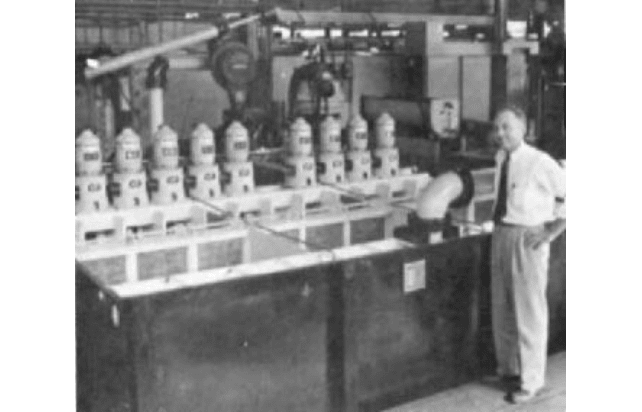
10.22 CHAPTER TEN
minimal disturbance will be felt by the pumps. A tendency for eddies to form (and create
vortices) can be minimized by placing wing walls upstream and downstream to control
velocity.
Testing Model Pit Design When the basic rules for good pump suction pit design are
adhered to, no model test will be required to ensure proper operation of the pumps and
pumping system. The substance of these rules is to keep a straight-in approach at a con-
stant low velocity from the water source to the pump chamber. The ANSI/Hydraulic Insti-
tute Standard dimensions and charts satisfy these criteria for the average pump in
general application.
Site layout problems may make the ideal solution impossible. Structural and environ-
mental requirements may outweigh hydraulic requirements in some instances. When the
ideal pit may not be possible or economically feasible, a model test should be considered.
It should be noted that the ideal dimensions are a composite covering not only a range of
specific speeds but also a complex melding of pump design philosophies. Some variation
from ideal dimensions should be expected from individual pump manufacturers.
Pump manufacturers are not in a position to guarantee the pump pit design. Differ-
ences of opinion between the structural and hydraulic pit design engineers and the pump
design engineers may best be resolved by performing a model pit test (Figure 17). Refer
also to Section 10.2.
Vortexing The real problems resulting from improper pit design occur largely on the
water surface in the form of vortices, or cones, produced by localized eddies on the surface
of the water. If this disturbance continues, the flow of water will carry the underwater part
of the vortex down toward the pump suction bell and ultimately into the pump (Figure
18). This introduces air into the impeller and will affect the mechanical radial balance of
the impeller by interrupting the normal solid-liquid flow pattern. This type of disturbance
will produce hydraulic pulsations in the pump flow and mechanical overloading of bear-
ings and impeller guides.
Underwater vortexing sometimes occurs in round pits or in pits where the pump suc-
tion bell is at some distance from the rear wall. Flow past the suction bell strikes the rear
FIGURE 17 Model pit test setup with fixed screens and pumps and valves for variable flow, to scale (Flowserve
Corporation)
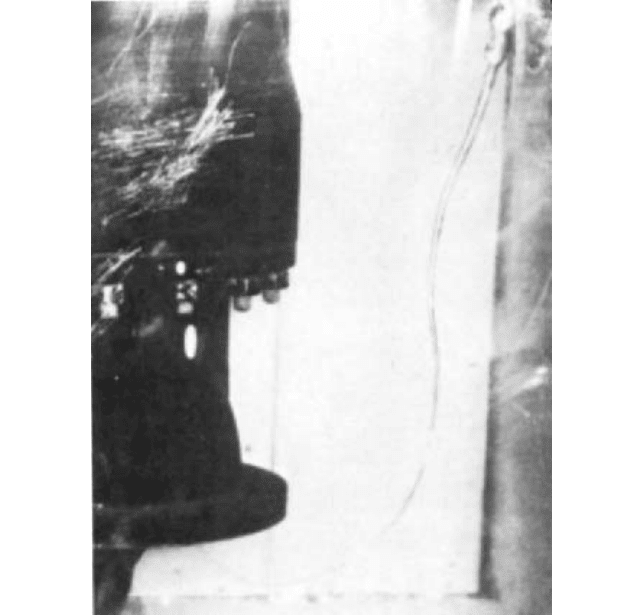
10.1 INTAKES, SUCTION PIPING, AND STRAINERS 10.23
FIGURE 18 Surface vortex drawing air into pump suction bell
wall and rolls back toward the bell, forming an eddy current that disturbs the normal flow
into the pump. In a round pit, a cross baffle below the pump bell may reduce this effect.
Where the pump is some distance from the back wall, a wall can be installed near the
pump, or a horizontal baffle at suction bell level behind the pump will also reduce the dis-
turbance. In all cases, the distance between the suction bell and the bottom of the pit
should not be more than one-half the suction bell diameter, and one-third the diameter is
preferable.
The use of the suction bell diameter as a basis for spacing should be carefully evaluated.
It will be seen that there is nothing magical in this relationship, especially when several
pump manufacturers all use different bell diameters. The real criterion is the allowable
velocity at the suction bell. It has been found that very-low-head pumps are much more
sensitive to bell velocity over 6 ft/s (1.8 m/s). For example, the velocity head loss at the bell
inlet with a high velocity may be such a large percentage of total pump head that efficiency
could drop as much as 10%. A good design rule for safe operation can be related to pump
head. For pumps having up to a 15-ft (4.6-m) head, the suction bell velocity should be held
to 2.5 ft/s (0.76 m/s); up to 50-ft (15-m) head, 4 ft/s (1.2 m/s); and above 50-ft (15-m) head,
5.5 ft/s (1.7 m/s). These values should be used for any substantial amount of pumping, but
for occasional short-term pumping, they can be exceeded without destroying the pump.
Vortices may be broken up and effectually nullified by arrangements of baffles and
vanes, or they may be prevented from occurring initially by a proper pit design. The only
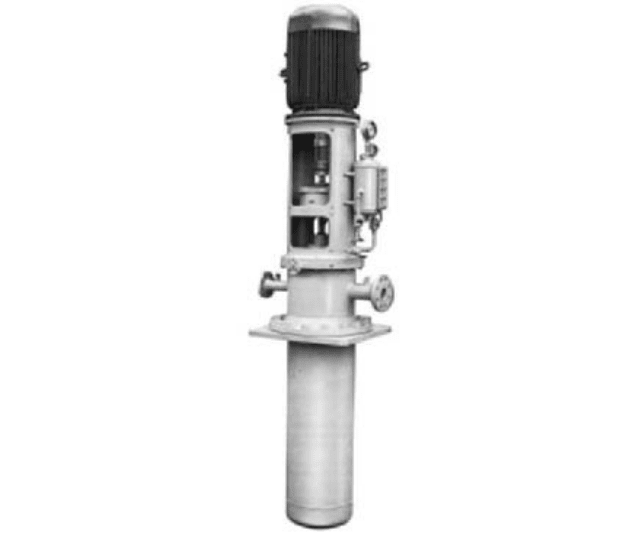
10.24 CHAPTER TEN
way to determine what type of baffling should be used and its effectiveness is by model
testing. Methods of eliminating vortexing are discussed in Section 10.2.
Vortices are usually generated when the flow direction of the liquid to be pumped
changes or when there is high velocity past an obstruction, such as a gate inlet corner,
screen pier, or dividing wall. In combination, these two causes invariably generate vor-
texes. For this reason, the pump suction pit should be immediately preceded by a straight
channel in which the velocity does not exceed 1.25 ft/s (0.4 m/s). Satisfactorily operating
pump pits with higher velocities are rare and should not be put into operation without the
assurance of a model study.
An additional condition likely to generate vortexes is a multiple pump pit with indi-
vidual cells in which only a portion of the pumps will operate simultaneously. The dead
space behind the non-operating pump will have flowing water tending to reverse direction
and form eddies. Eddies and vortices can be avoided by eliminating or venting the walls
at the rear of the pit. It also helps to position the pumps at the extreme rear of the pit.
Alternatively, expensive modifications to the pit, such as splitter walls and baffles, may be
required (Figure 7).
Round pits tend to generate vortices, especially when the pump is centered in the pit.
These vortices usually occur around the pump column because of eccentric inlet flow. Spe-
cial cases of the round pit are tolerable either when a Ranney well (Figure 6) is used or
when there are booster pumps in the pipelines (Figure 19). In the Ranney well, the ratio
of pump size (and flow) to pit size (and capacity) is such that very low velocity exists, as in
a lake inlet. Water comes into the Ranney well all around the periphery. These conditions
of direct flow and low velocity prevent vortexing. Booster pumps installed in a circular can
FIGURE 19 Booster pump suspended in a steel well (or can) that requires a minimum space for suction pit
(Flowserve Corporation)
10.1 INTAKES, SUCTION PIPING, AND STRAINERS 10.25
(suction tank) must be centered in the can, and all inlet velocities to the can and flow in
the can and into the pump must be uniform and high enough to provide fluid control. This
velocity will vary from 4 to 6.5 ft/s (0.76 to 1.98 m/s).
Vortices are not generated by a pump or pump impeller and so do not fall into clockwise
or counterclockwise rotation because of the pump rotation. Also, in a pump pit, vortices do
not have a directional rotation induced by the rotation of the earth and therefore are not
of opposite rotations above and below the equator, as is the case with “bathtub vortexing,”
which occurs in tanks being drained without pumps.
Submergence Centrifugal pumps in intake pumps must be submerged deeply enough
to provide
• A pressure sufficient to prevent cavitation in pump first-stage impellers, referred to as
NPSH (it is assumed that the proper pump has been selected to perform satisfactorily
with available NPSH)
• Prevention of vortexing and associated pit flow problems detrimental to pump operation
A pump may have adequate submergence from a pressure standpoint and still be
lacking in sufficient depth of cover above the suction inlet to prevent surface air from
being drawn in.Any wet-pit pump must have its suction inlet submerged at all times, and
for continuous pumping every pump will have a fixed minimum submergence require-
ment. Because this relates to velocity, there are two basic parameters: the suction inlet
diameter and the depth of water above the inlet lip. As pump size (and flow) increase, the
inlet velocity may stay constant as the bell diameter increases, but at the same time, the
impeller distance above the suction inlet becomes larger, so a fixed submergence value
would lead to increased surface velocity, peripheral drawdown, and an increase in air
intake.
Basically, submergence must of necessity increase with pump size. For the final deter-
mination, some balance must be struck between submergence and pit width to satisfy an
average flow velocity of 1 to 1.25 ft/s (0.3 to 0.4 m/s) and maintain reasonable economic
balance between excavation costs, concrete costs, and screen costs without neglecting eco-
logical requirements and still fulfilling the primary need for circulating water in adequate
quantities.
SUCTION TANKS _____________________________________________________
There are a variety of shapes and configurations for suction tanks. They may be vertical
or horizontal, cylindrical, or rectangular. Outlets from the tanks may be vertically down-
ward, horizontal, from either the side or bottom of the tank, or in the case of a pressurized
tank, vertically upward. The formation of vortices in the tank can cause air or gas entrap-
ment even when the tank outlet is fully submerged. This can cause pulsating pump flow,
noisy operation or a reduction in pump performance.
To determine minimum submergence of the outlet pipe in the tank, the Hydraulic
Institute recommends the following relationship:
where F
D
Froude number V/(gD)
0.5
D outlet fitting diameter, ft (m)
S submergence, ft (m)
V outlet fitting velocity, ft/s (m/s)
g acceleration of gravity, ft/s
2
(m/s
2
)
Figure 20 shows examples of how to apply the calculated submergence value depend-
ing on tank orientation and outlet configuration. Figure 21 shows how to use the above
equation to calculate velocity for the Froude number calculation, depending on type of
S>D 1.0 2.3F
D
,
